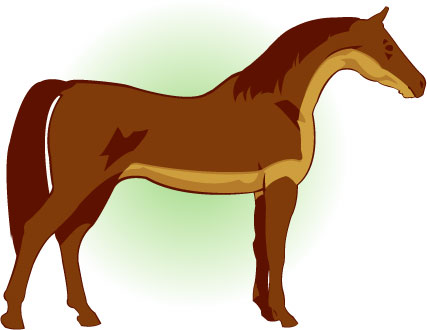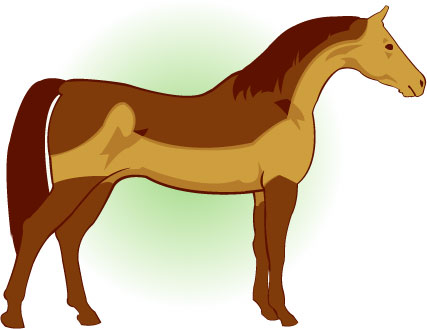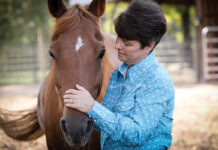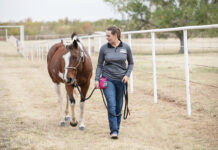Unless you live in the tropics, winter riding means dealing with frigid temperatures, icy footing and frozen extremities. And oh yes, did we mention that woolly mass of fuzz that replaces your horse’s once slick and shiny coat? This layer is Mother Nature’s way of providing horses with the protection they need to survive winter. Depending upon your plans for winter riding, this is good news or bad news.
As veterinarian Elizabeth K. Stanley from Stonefield Equine Clinic in Winsted, Conn., explains, “The oils and hair in a horse’s winter coat will shield him from wet and cold, but add wind to that scenario and an unprotected horse will get into trouble.”
This is why horses in the wild naturally seek shelter under trees or outgrowths, and why a wild herd stays banded together, rump to rump, to provide protection from wind in a storm.
Dr. Stanley keeps her 31-year-old retired eventer, Floyd, at her farm, and notes that “he hasn’t worn a blanket in years.” She provides Floyd with a three-sided run-in shed for winter housing which, in conjunction with his heavy coat, allows him to live comfortably outdoors all winter.
Provided you give your horse winter shelter and proper care in harsh conditions—available fresh water, generous nutrition and appropriate shoeing as determined by your particular footing conditions—your horse will make it through winter just fine without added blanket expense or worry on your part.
The bad news? Just try to ride with all that hair. Exercise your horse enough to work up any sort of lather, and you’ll spend hours drying him off. In winter you can’t just let a horse get sweaty, then fend for himself in the cold.
So you’re faced with a dilemma: to clip or not to clip? Would you rather deal with hair or blankets? Or some of each?
Weighing Your Decision
First, determine what kind of riding you plan to do this winter. If you don’t have access to an indoor ring, does winter footing and weather limit you to walks down frozen roads for the next few months? If so, why clip at all? Those winter strolls won’t work your horse into a sweat, so you won’t have to worry about drying him off.
On the other hand, will you be moving to an indoor ring and riding actively all season? Then a full-body clip or hunter clip is probably in order. You’ll need to purchase several blankets to protect a fully clipped horse properly—a sheet and various stable rugs, which can be layered for changing conditions; a quarter-sheet to keep his back warm on really cold days; and a turnout rug for outdoor protection.
But if you’re like most of us, your riding schedule probably fits somewhere in between these two extremes. And if your level of riding activity varies mightily according to the weather, these partial clips may be the perfect solution.
The Best of Both Worlds
Several clipping options allow you to get the best of both worlds—remove hair where your horse sweats the most, but leave enough to provide warmth. Which one you choose depends on your level of riding activity, your climate, and your horse’s turnout, barn and lifestyle conditions.
Even the most modest of clip jobs, however, requires some sort of blanketing. When you remove a horse’s hair you expose his skin to the cold. If you clip, you’ll need to commit to daily blanketing and unblanketing.

The Strip Clip:
Short, cold winter days reduce many of us to weekend-only riding. If that’s your situation, this clip might work for you. Remove hair only in a thin strip from the horse’s jowl down the underside of his neck and under his chest. Only go as far here as needed; you can stop just at the girth area or continue the clip under and along his belly.
You can also take this clip one step further, clipping a large triangle from his neck to his flank. You’ll remove all the hair under his belly this way, plus you’ll trim hair from the lower part of his shoulder as well.
This clip leaves hair everywhere a horse needs it most—along his back, flanks, head and upper neck. Your horse would probably do nicely and continue to live outdoors with just one medium weight stable (for indoors) or turnout blanket to protect his naked areas.

The Low Trace Clip:
You plan to ride all winter but you don’t have an indoor ring. Your horse’s work load will depend on the weather—walking in bad footing, regular work when your outdoor ring thaws. This clip will allow your horse ventilation in active training, while giving him protection during those long cold walks.
Remove hair in a triangle starting from underneath his jowl down to his chest. Then swing the line back, starting about four to six inches above his elbow, straight to his hindquarters. You’ll also remove the hair beneath his belly, and you can remove hair underneath his chin, too, if you prefer. Because the upper part of his hind legs will be free of hair, you can afford active riding without worrying about excessive sweating.
A horse with a low trace clip could probably still live outside, but will need greater protection in turnout and certainly one warm stable blanket even when indoors.
The Medium Trace Clip:
If you live in a climate where winter provides more active riding days, where faster work or jumping might be possible, choose this clipping option. Start as per the low trace clip, but swing the line back from a much higher point—from midway down his shoulder, back to a line that ends about half-way down his hindquarters. (The line will hit a level that’s about even with the bottom of your saddle flap.)
A horse should not live outside with this much hair removed unless he’s in a temperate region—and even then he’ll need blanketing. This clip will probably require one medium stable rug, one medium turnout and a stable sheet or lighter blanket to layer under both in extreme cold.

The High Trace Clip:
This clip is designed for horses that maintain a regular work load in the winter. The advantage to this clip over a full-body clip is that hair is left along his back and upper neck for protection during cold-weather rides, so you shouldn’t need a quarter sheet for riding.
You may opt to clip part or all of the head with either the medium or high trace clip. Once you clip a horse’s head, however, remember that you’ll have to limit his turnout time in severe weather, since you can’t protect his vulnerable face and ears with regular blankets unless you buy him some sort of hood.
The high trace clip demands that you blanket your horse just as you would a horse with a full body clip. You’ll need two to three layers of stable and turnout blankets, which can be rotated according to the weather.

The Blanket Clip:
Perhaps you plan to work actively indoors all winter, yet you’d still like to go outdoors when the weather suits. The blanket clip removes all hair from his body, except for a square patch along his back, loins and croup much like that of a quarter sheet. The line of the blanket clip should reach the bottom of your saddle flap.
You’ll need to blanket this clip as you would the horse with a high trace clip.

The Hunter Clip:
This clip is another choice for active riders. Though it doesn’t offer much warmth, and the horse will have to be blanketed as if he were fully clipped, the hunter clip does leave some hair for protection in the saddle area and on the horse’s legs.
How to Clip Straight Lines
Partial clip jobs, like the trace and blanket clip, make for faster clipping since you’re only removing hair from part of the horse. However, you need a steady hand and an experienced eye for this type of clipping. The lines on these clips are very apparent. Here are a few tips on how to keep yours straight:
- Use sharp blades. You can’t clip a straight line with a dull blade. Always clip your lines at the start of your clipping job, before your blades have dulled. Make sure your blades are clean and oiled before you attempt to cut lines. If you’re lucky enough to have two pairs of clippers, keep one set for lines and use the other for body hair.
- Stand your horse on an even surface. You can’t clip a straight line if your horse is standing on uneven ground, or if he’s resting a hind leg.
- Mark your lines. Use chalk, nontoxic colored markers, masking or adhesive tape, or a damp bar of saddle soap to mark your lines before you clip.
- Use a yardstick or a horse-measuring stick to ensure your lines are equal heights on both sides of your horse’s body.
- Keep your horse quiet while you clip. You can’t clip a straight line on a moving target.
- Turn your clippers: To neaten lines, try turning your clippers sideways as you go. Or, place the top of your blade against the line and lift straight away from your horse’s body.Clipping your horse gets rid of that unwanted hair, but once you make the cut, you’re committed to blanketing him, a routine that gets both expensive and cumbersome.
Choosing Blankets
Making blanket statements about blanketing—pardon the pun!—is difficult since conditions vary so much in different parts of the country. You need to consider your horse’s living conditions, plus the climate where you live, as you make blanket selections.
Here are some tips to guide you. Special thanks to Cyndy Williams, a buyer for Dover Saddlery (Dover, Mass.), for providing much of the information here.
- Just as high-tech fabrics have revolutionized athletic clothing for people, you can now find fabrics that wick moisture away from your horse, waterproof blankets and outer shells tough enough to withstand the abuse horses give them in rough and tumble turnout play.
- Blanket designs, too, have changed. You can choose among “extras” for blankets like leg straps, gussets that allow for shoulder movement in turnout rugs, hoods, high cuts that cover the withers and neck, even designs that protect your horse’s belly.
- For outdoor (turnout) blankets, you can choose from a thread-count, known as denier, from 600 to 1700. The higher the denier, the tougher the outer shell of the rug.
- Look for turnout blankets without a back seam—or make sure the back seam is reinforced—on the top of the blanket. Seams always allow for the possibility of water leakage.
- Shoulder gussets and tail flaps allow greater protection/freedom of movement in outdoor rugs.
- Stable and turnout blankets alike come in a variety of “fill” levels—from 180 grams to 400 grams—which determine the warmth of your blanket. Remember that a horse can catch cold from too much warmth. Overblanket him, especially in the barn, and he can sweat and ultimately catch a chill.
- Turnout blankets can double as stable blankets provided they stay dry. Never leave a horse stabled in a wet rug. Depending on your weather conditions, you’re probably better off having separate indoor and outdoor blankets. You can always layer a stable blanket underneath a turnout blanket for added warmth.
Drying Your Horse’s Winter Coat in Cold Weather
If you do choose to leave your horse unclipped, be prepared to dry him properly once he’s worked up a sweat under tack.
Curry his wet hair as best you can to release some moisture. Then cover him in an Irish-knit or anti-sweat sheet that contains “holes” in the fabric, allowing the air to reach his coat. Cover this with a wool cooler or a high-tech cooler that will wick moisture away from the horse.
If his coat is really drenched, you may need to change these rugs as they become saturated. Once he is dry, remove the wet rugs. You wouldn’t spend hours in a wet towel after your shower, would you?
Winter riding doesn’t have to be a chore, and with these options, the right hairdo for your horse is in your reach.
This article first appeared in the October 2004 issue of Horse Illustrated magazine. Click Here to subscribe.





